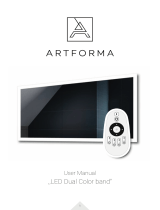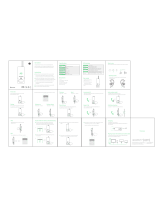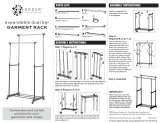Page is loading ...

FAMILIARISATION
EXTERIOR
Guide-me-home lighting
After switching off the ignition, the head-
lamps remain on briefl y to make your exit
from the vehicle easier when the light is
poor.
67, 68
ASR and ESP systems
These systems are linked to assure the
directional stability of the vehicle within
the limits of the laws of physics.
94
Glass sunroof
This roof provides incomparable visibility
and light in the passenger compartment.
62
Rear parking sensors
This system warns you if an obstacle is
detected behind the vehicle when re-
versing.
109

FAMILIARISATION
OPENING
Remote control key
A. Unfolding/Folding the key.
Locking
(press once; fi xed lighting of
the direction indicators).
Glass sunroof
Lift the handle of the blind concerned
and release.
Each blind is fi tted with a roller in which
it is stored when released.
Deadlocking
(press twice in succession;
fi xed lighting of the direction
indicators).
Unlocking of the vehicle
(rapid fl ashing of the direction indicators).
53 62
Fuel tank
63
1. Opening the fuel fi ller fl ap.
2. Opening and hooking the fuel fi ller
cap.
Capacity of the tank: approximately
50 litres (petrol) or 48 litres (Diesel).

FAMILIARISATION
OPENING
Boot 2-position adjustable boot
This 2-position adjustable boot fl oor
permits:
-
the volume of the boot to be maximised
,
- the boot to be partitioned (storing of
the rear parcel shelf...),
- the fl oor to be levelled from the boot
opening to the front seats, when the
rear bench seat is in folded and fully
back.
1. Unlocking the vehicle.
2. Opening the boot.
61
82
A. Interior bonnet release.
B. Exterior safety catch.
C. Bonnet stay.
112
Bonnet

FAMILIARISATION
INTERIOR
Scented air freshener
This air freshener diffuser diffuses
the fragrance that you have selected
throughout the passenger compartment
by means of its location in the ventila-
tion system.
46
Dual-zone digital air conditioning
This system allows you to set a different
level of comfort for the driver and front
passenger. It then controls this level
automatically relative to the ambient
conditions.
44
Cruise control/speed limiter
These two functions control the speed
of the vehicle in relation to the value
that you have programmed.
105/107
Audio and communication systems
These systems benefi t from the latest
technology: MP3 compatible audio sys-
tem, MyWay audio and navigation sys-
tem, auxiliary sockets, emergency or
assistance call.
153

FAMILIARISATION
INSTRUMENTS AND CONTROLS
1. Steering lock and ignition.
2. Audio equipment steering mounted
controls.
3. Wipers/screenwash/trip computer
control stalk.
4. Instrument panel.
5. Driver’s airbag.
Horn.
6. Gear lever.
7. Open storage compartment.
8. Door mirror controls.
Electric window controls.
Rear electric windows and doors
deactivation control.
9. Passenger’s airbag deactivation.
10. Manual headlamp height
adjustment.
11. Front side window demisting vent.
12. Speaker (tweeter).
13. Windscreen demisting vent.

FAMILIARISATION
INSTRUMENTS AND CONTROLS
1. Steering wheel adjustment control.
2. Cruise control/speed limiter switches.
3. Lighting and direction indicators
control stalk.
4. Central adjustable air vents.
5. Storage tray.
Scented air freshener.
6. Sunshine sensor.
7. Passenger’s airbag.
8. Side adjustable air vent.
9. Glove box.
Fusebox.
10. Bonnet release.
11. Dynamic stability control (ESP/ASR)
button.
Parking sensors button.
Central locking button.
Hazard warning lamps button.
12. Heating/air conditioning controls.
13. Audio equipment.
14. Emergency or assistance call.
15. 12 V socket (100 W max).
16. USB port/auxiliary socket.
17. Cup holder.
18. Parking brake.

FAMILIARISATION
SITTING COMFORTABLY
Driver’s seat adjustment
Forwards-backwards
47
Seat back angle Height

FAMILIARISATION
Steering wheel adjustment
1. Release the adjustment mechanism.
2. Adjust for height and reach.
3. Lock the adjustment mechanism.
SIT COMFORTABLY
Front seat additional adjustments
Head restraint height
52
Armrest
A. Releasing the armrest.
B. Adjusting the armrest.

FAMILIARISATION
SITTING COMFORTABLY
Door mirror adjustment
This operates with the ignition on.
From the driver’s seat, select the mirror
by moving the control 1 , to the left or to
the right, then adjust the mirror in the
four directions by moving the control 2 .
The demisting - defrosting of the mirrors
is linked with that of the rear screen.
Rear view mirror adjustment
1. Selection of the "day" position of the
mirror.
2. Mirror adjustment.
Front seat belt
1. Fastening.
2. Height adjustment.
52 95
Folding the mirrors
When parking, the mirrors can be folded
manually or electrically.
51

FAMILIARISATION
SEEING CLEARLY
Lighting
Ring A
Ring B
Raise or lower the lighting stalk passing
the point of resistance; the corresponding
direction indicators will fl ash for as long
as the stalk remains in this position.
Direction indicators
Switching on "AUTO"
Press the stalk down and release it.
Ring B: rear wiper
65 70
Lighting off.
Automatic illumination of head-
lamps.
Sidelamps.
Dipped/main beam headlamps.
Rear foglamp.
or
Front and rear foglamps.
Park.
Intermittent wipe.
Wash-wipe.
Stalk A: windscreen wipers
69
Wipers
Switching off "AUTO"
Push the stalk up and return it to
position "0" .
71
92
"Motorway" function
Push the lighting stalk up or down, with-
out passing the point of resistance; the
corresponding direction indicators will
fl ash three times.
This function can be used at any speed,
but it is particularly useful when chang-
ing lane on high-speed roads.

–
FAMILIARISATION
Digital air conditioning: we recommend use of the fully automatic mode by pressing the "AUTO" button, after selecting the
desired level of comfort.
VENTILATION
Recommended interior settings
I require...
Heating or Manual Air Conditioning
Air distribution Air fl ow
Air recirculation/
Intake of outside air
Temperature Manual A/C
HOT
COLD
DEMISTING
DEFROSTING

FAMILIARISATION
MONITORING
Translucent digital instrument panel Switch panel
A. With the ignition on, the level of fuel
remaining is displayed in the digital
instrument panel.
B. With the ignition on, the oil level in-
dicator should display "OIL OK" for
a few seconds.
If the levels are not correct, top up the
levels which are low.
Illumination of the indicator lamp indi-
cates the status of the corresponding
function.
A. Deactivation of the ESP/ASR system.
94
B. Deactivation of the rear parking sen-
sors.
110
C. Central locking.
60
With the ignition on, the orange and red
warning lamps come on.
With the engine running, these warning
lamps should go off almost immediately,
with the exception of warning lamp C
(passenger's front airbag activated) which
goes off after approximately one minute.
If warning lamps remain on, refer to the
relevant page.
Warning lamps
18 19

FAMILIARISATION
PASSENGER SAFETY
Passenger’s front airbag Electric child lock
1. Insert the key.
2. Select the position:
"OFF" (deactivation), with "rear fac-
ing" child seat",
"ON" (activation), with front passen-
ger or "forwards facing" child seat.
3. Remove the key keeping the switch
in the new position.
Illumination of the indicator lamp A indi-
cates that the electric child lock is on.
A. Front and/or rear seat belts not fas-
tened/unfastened warning lamp.
B. Front left seat belt warning lamp.
C. Front right seat belt warning lamp.
D. Rear right seat belt warning lamp.
E. Rear centre seat belt warning lamp.
F. Rear left seat belt warning lamp.
G. Passenger’s front airbag deactivat-
ed warning lamp.
H. Passenger’s front airbag activated
warning lamp.
Seat belts and passenger’s front airbag
96 100 91

FAMILIARISATION
DRIVING SAFELY
Speed limiter "LIMIT" Display in the instrument panel
1. Limiter mode Selection/Off.
2. Decreasing the programmed value.
3. Increasing the programmed value.
4. Speed limiter On/Off.
The cruise control or speed limiter mode
appears in the instrument panel when it
is selected.
1. Cruise control mode Selection/Off.
2. Programming a speed/Decreasing
the programmed value.
3. Programming a speed/Increasing
the programmed value.
4. Cruise control Off/Resume.
Cruise control "CRUISE"
107 105
In order to be programmed or activated,
the vehicle speed must be higher than
25 mph (40 km/h), with at least fourth
gear engaged on the manual gearbox.
The values must be set with the engine
running.
Cruise control
Speed limiter

i
18
MONITORING
PETROL - DIESEL INSTRUMENT PANEL
Panel grouping together the digital indicator, the multifunction screen and the
vehicle operation indicator lamps.
1. Rev counter.
Indicates the speed of rotation of the
engine (x 1 000 rpm).
2. Rev counter zone indicating that you
must change up a gear.
3. Speed limiter
or
Cruise control.
(mph or km/h)
4. Electric child lock indicator lamp.
Indicates, for a few seconds, the
activation of the electric child lock
(deactivation of the rear windows
and doors).
Translucent digital instrument panel
This screen groups together the warn-
ing and information messages.
Multifunction screen
Indicator lamps display zone
This zone groups together the vehicle
operation indicator lamps.
Display zero reset button
This permits resetting of the function
selected to zero (trip distance recorder
or service indicator).
Instrument panel lighting button
This adjusts the brightness of the light-
ing of the instruments and controls.
For more information, refer to the
paragraph relating to the button or
function and its associated display.
5. Fuel level.
Indicates the quantity of fuel remain-
ing in the tank.
6. Vehicle speed.
Indicates the current speed of the
moving vehicle (mph or km/h).
7. Trip distance recorder.
(miles or km)
8. Service indicator.
(miles or km) then,
Distance recorder.
(miles or km)
9. Engine oil level indicator.

!
19
MONITORING
Certain warning lamps may come
on in two different modes. Only by
relating the type of lighting to the
operating status of the vehicle can
it be ascertained whether the situ-
ation is normal or whether a fault
has occurred.
Indicator and warning lamps
Visual indicators informing the driver that a system is in operation (operation or deactivation indicator lamps) or of the
occurrence of a fault (warning lamp).
Associated warnings
The switching on of certain warning lamps may be accompanied by an audible
signal and a message on the multifunction screen.
The warning lamps may come on continuously (fi xed) or fl ash.
Operation indicator lamps
If one of the following indicator lamps comes on, this confi rms that the corresponding
system has come into operation.
When the ignition is switched on
Certain warning lamps come on for a few seconds when the vehicle's ignition is switched on.
When the engine is started, these same warning lamps should switch off.
If they remain on, before moving off, refer to the information on the warning lamp concerned.
Warning lamp is on Cause Action/Observations
Left-hand
direction
indicato r
fl ashing with
buzzer.
The lighting stalk is pushed
down.
Right-hand
direction
indicator
fl ashing with
buzzer.
The lighting stalk is pushed
up.
Sidelamps fi xed.
The lighting stalk is in the
"Sidelamps" position.
Dipped beam
headlamps
fi xed.
The lighting stalk is in the
"Dipped beam headlamps"
position.
Main beam
headlamps
fi xed.
The lighting stalk is pulled
towards you.
Pull the stalk to return to dipped beam headlamps.

20
MONITORING
Warning lamp is on Cause Action/Observations
Front
foglamps
fi xed.
The front foglamps are
switched on.
Turn the ring on the stalk rearwards twice to switch
off the front foglamps.
Rear
foglamps
fi xed.
The rear foglamps are
switched on.
Turn the ring on the stalk rearwards to switch off
the rear foglamps.
Diesel engine
pre-heating
fi xed.
The ignition switch is at the
2nd position (ignition on).
Wait until the warning lamp has switched off before starting.
The duration for which the warning lamp is on is determined
by the climatic conditions.
Parking brake fi xed.
The parking brake is applied
or not properly released.
Release the parking brake to switch off the warning
lamp, keeping your foot on the brake pedal.
Observe the safety recommendations.
For further information on the parking brake, refer to
the "Driving" section.
Engine
coolant
temperature
fi xed blue .
On starting the engine, it
indicates that the engine is
cold.
After a few minutes driving, it swiches off to
indicate that the engine temperature is normal.
In order to protect your engine, avoid driving too
hard until the warning lamp has switched off.
Passenger’s
airbag
system
fi xed.
The control switch, located
at the driver’s end of the
dashboard, is in the " ON "
position.
The passenger’s front airbag
is activated.
In this case, do not install a
rear-facing child seat.
Turn the control switch to the " OFF " position to
deactivate the front passenger’s airbag.
In this case you can install a rear-facing child
seat.
The passenger’s airbag system is automatically
put into service on starting the vehicle ( " ON " posi-
tion).
Electric child
lock
temporarily.
The electric child lock is ac-
tivated.
Displayed for a few seconds after activating the
function and every time the ignition is switched on.
For more information, refer to the "Child safety"
section.

21
MONITORING
Deactivation indicator lamps
If one of the following indicator lamps comes on, this confi rms that the corresponding system has been switched off intentionally.
This is may be accompanied by an audible signal and a message on the multifunction screen.
Warning lamp is on Cause Action/Observations
Passenger’s
airbag
system
fi xed.
The control switch, located
at the driver’s end of the
dashboard, is set to the
"OFF " position.
The passenger’s front airbag
is deactivated.
In this case you can install a
"rear facing" child seat.
Set the control switch to the "ON" position to acti-
vate the passenger’s front airbag. In this case, do
not fi t a child seat in the rear-facing position.
The passenger’s airbag system is put into service
automatically when the vehicle is started ( "ON"
position).
ESP/ASR fi xed.
The button, located in the
middle of the dashboard, is
pressed. Its indicator lamp
is on.
The ESP/ASR is deactivated.
ESP: electronic stability pro-
gramme.
ASR: anti-skid regulation.
Press the button to activate the ESP/ASR. Its
indicator lamp switches off.
The ESP/ASR system is activated automatically
when the vehicle is started.
If deactivated, the system is reactivated automati-
cally from approximately 30 mph (50 km/h).

!
22
MONITORING
Warning lamps
When the engine is running or the vehicle is
being driven, the switching on of one of the fol-
lowing warning lamps indicates a fault which
requires action on the part of the driver.
Any fault resulting in the switching on of a warning lamp must be investigated
further by reading the associated message on the multifunction screen.
If you encounter any problems, do not hesitate to contact a CITROËN dealer.
Warning lamp is on Cause Action/Observations
STOP
fi xed, associated
with another
warning lamp,
accompanied by
an audible signal
and a message
on the screen.
It is associated with the braking
system, the power steering,
the engine oil pressure or the
engine coolant temperature.
Stop as soon as it is safe to do so.
Park, switch off the ignition and call a CITROËN
dealer.
Service
temporarily,
accompanied
by an audible
signal and a
message on the
multifunction
screen.
A minor fault has occurred
for which there is no specifi c
warning lamp.
Identify the fault by reading the message shown
on the screen, such as, for example:
- engine oil level,
- screenwash level,
- remote control battery,
- state of the bulbs,
- saturation of the particle emission fi lter (Diesel).
For any other faults, contact a CITROËN dealer.
fi xed, accompanied
by an audible signal
and a message on the
multifunction screen.
A major fault has occurred
for which there is no specifi c
warning lamp.
Identify the fault by reading the message shown
on the screen and contact a CITROËN dealer.
Braking
fi xed, associated
with the STOP
warning lamp.
The braking system fl uid
level is too low.
You must stop as soon as it is safe to do so.
Top up with brake fl uid recommended by CITROËN.
If the problem persists, have the system checked
by a CITROËN dealer.
+
fi xed, associated
with the STOP and
ABS warning lamp.
The electronic brake force
distribution (EBFD) system
has a fault.
You must stop as soon as it is safe to do so.
Have it checked by a CITROËN dealer.

23
MONITORING
Warning lamp is on Cause Action/Observations
Anti-lock
Braking
System
(ABS)
fi xed.
The anti-lock braking system
has a fault.
The vehicle retains conventional braking.
Drive carefully at reduced speed and contact a
CITROËN dealer without delay.
Dynamic
stability
control
(ESP/ASR)
fl ashing.
The ESP/ASR regulation is
active.
The system optimises traction and improves the
directional stability of the vehicle.
fi xed.
Unless it has been deactivated
with the indicator lamp on
the button on, the ESP/ASR
system is faulty.
Have it checked by a CITROËN dealer.
Engine
autodiagnosis
system
fi xed.
The emission control system
has a fault.
This lamp should switch off when the engine is
started.
If it does not switch off, contact a CITROËN dealer
urgently.
fl ashing.
The engine management
system has a fault.
Risk of destruction of the catalytic convertor.
Have it checked by a CITROËN dealer.
Low fuel level fi xed.
When it fi rst comes on there re-
mains approximately 5 litres
of fuel in the tank.
You must refuel as soon as possible to avoid
running out of fuel.
This warning lamp will come on every time the
ignition is switched on, until a suffi cient addition
of fuel is made.
Fuel tank capacity: approximately 50 litres (petrol)
or 48 litres (Diesel).
Never continue to drive until you run out of fuel
as this could damage the emission control and
injection systems.
/


